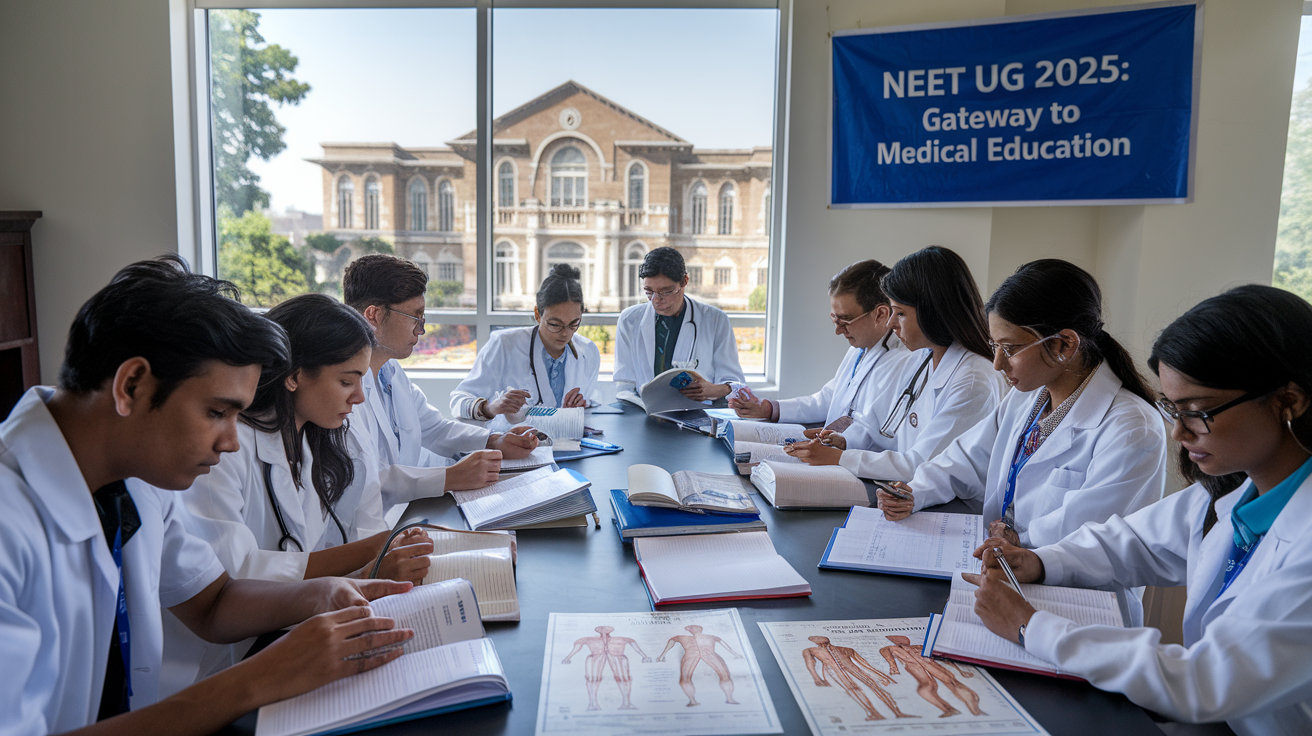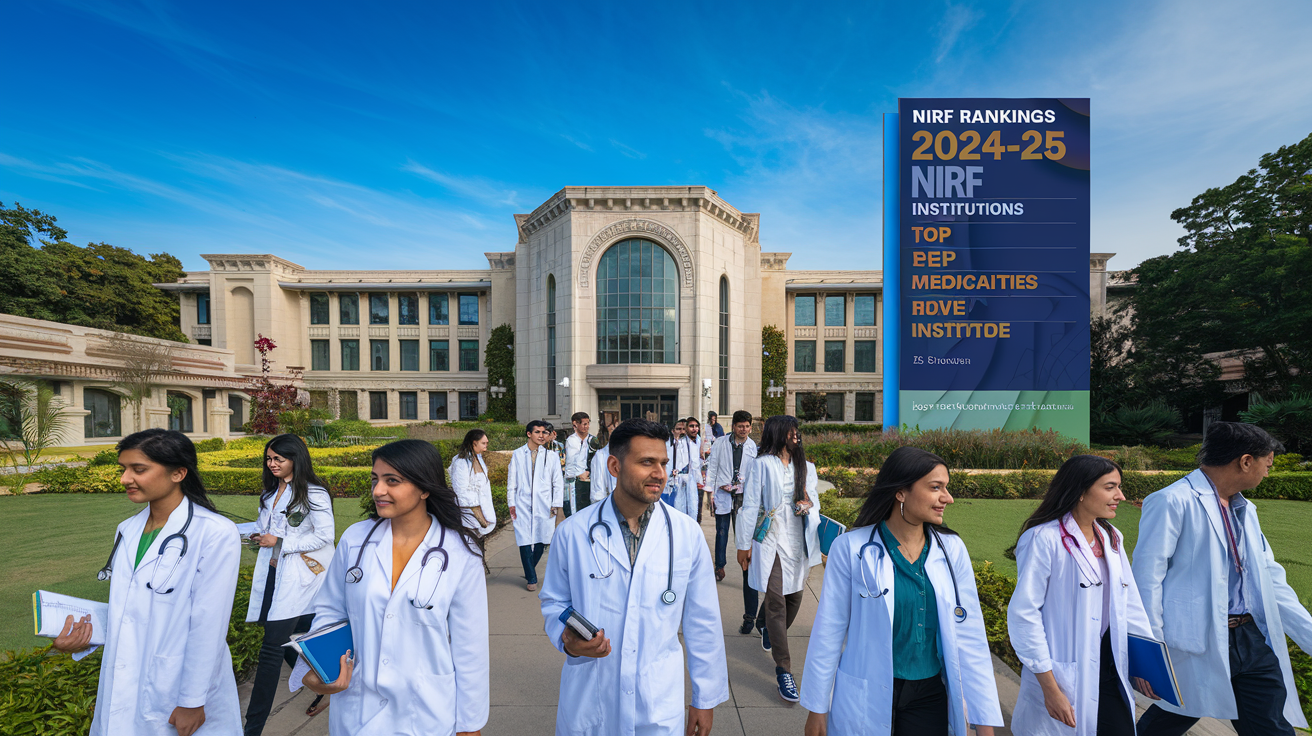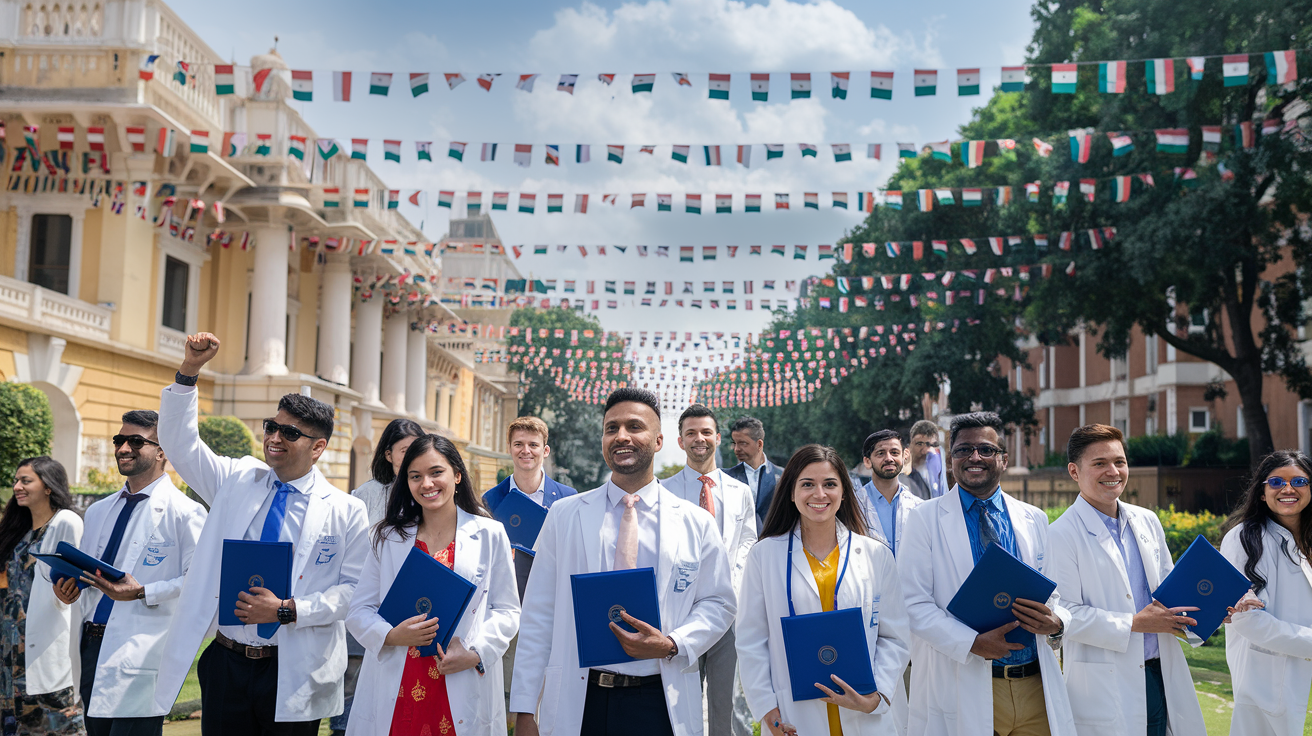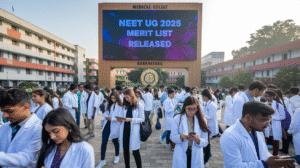Top Medical Colleges in India 2025: Ranking, Admissions, Fees, NEET Cutoff, Placements
Are you dreaming of donning that white coat and stethoscope, but feeling overwhelmed by the maze of medical college options in India? With 779 recognized medical institutions across the country—427 government and 352 private—choosing the right path for your medical journey can feel like diagnosing a complex case without proper tools. As NEET UG 2025 approaches, the pressure to make an informed decision that balances quality education, affordability, and career prospects only intensifies.
The stakes couldn’t be higher. Your choice of medical college will shape not just the next 5.5 years of your life, but your entire professional future. From the prestigious AIIMS Delhi with its world-class faculty to regional powerhouses like CMC Vellore where tuition costs as little as ₹13,500 while graduates secure packages averaging ₹4.34 LPA—each institution offers a unique combination of advantages and considerations. 💼 The difference between selecting the right or wrong medical college could mean variations of millions of rupees in your education investment and future earnings.
In this comprehensive guide, we’ll walk you through everything you need to know about the top medical colleges in India for 2025. You’ll discover the latest NIRF rankings, admission requirements through NEET UG, detailed fee structures, expected cutoffs, impressive placement records, and practical strategies for selecting the institution that perfectly aligns with your career aspirations. Whether you’re aiming for government colleges like PGIMER Chandigarh or private institutions such as St. John’s Medical College, this roadmap will help you navigate your way to medical excellence.
NEET UG 2025: The Gateway to Medical Education in India

NEET UG 2025: The Gateway to Medical Education in India
NEET UG as the Sole Entrance Exam for MBBS and BDS Programs
The National Eligibility Entrance Test for Undergraduate courses (NEET UG) has established itself as the mandatory standardized assessment for aspiring medical students across India. If you’re looking to pursue a career in medicine, you should know that NEET UG serves as the exclusive gateway to various medical programs. Beyond the traditional MBBS and BDS courses, NEET UG is now the uniform entrance test for multiple medical disciplines including Bachelor of Ayurvedic Medicine and Surgery (BAMS), Bachelor of Unani Medicine and Surgery (BUMS), Bachelor of Siddha Medicine and Surgery (BSMS), and Bachelor of Homeopathic Medicine and Surgery (BHMS).
The National Testing Agency (NTA), established by the Ministry of Education (formerly known as the Ministry of Human Resource Development), oversees this comprehensive examination. The NTA’s primary goal is to ensure that the testing process remains efficient, transparent, and aligned with international standards. This standardization helps you gain access to premier medical institutions throughout India through a single examination rather than preparing for multiple tests.
Key Exam Details: Date (May 4, 2025), Mode, and Eligibility Requirements
For your 2025 medical entrance preparation, here are the critical details you need to know:
- Exam Date: NEET UG 2025 is scheduled for May 4, 2025
- Admit Card Release: April 25, 2025
- Mode of Examination: Offline (pen and paper-based)
- Duration: 200 minutes (3 hours and 20 minutes)
- Application Timeline:
- Application form release: February 7, 2025
- Last date for submission: March 7, 2025
- Correction window: March 9-11, 2025
The application process is entirely online, requiring you to register with a valid email address and mobile number. The application fees vary based on your category:
- SC/ST/PWD: INR 1,000
- Other Indian candidates: Higher fees (exact amount not specified in reference)
- International candidates: INR 9,500
For eligibility, you must:
- Be an Indian National or an Overseas Citizen of India (OCI)
- Meet specific age requirements
- Have passed 12th standard with Physics, Chemistry, and Biology
The exam structure consists of 180 multiple-choice questions across Physics, Chemistry, and Biology subjects. The marking scheme awards +4 points for correct answers and deducts -1 for incorrect responses. To optimize your preparation, you should adhere to the official syllabus and practice with previous years’ papers.
Understanding NEET Cutoffs and Their Significance for College Admission
The NEET cutoff scores play a crucial role in determining your eligibility for admissions to the Top Medical Colleges in India 2025. After the examination, the NTA will release the answer key, results, and merit list, with counseling for qualifying candidates expected to commence in July 2025.
The cutoff marks for qualification are determined by several factors, including:
- The total number of candidates appearing for the exam
- The difficulty level of the examination
- The number of available seats
For NEET UG 2025, the expected minimum qualifying percentile is 50% for general category candidates. These cutoffs serve as the preliminary screening mechanism that determines whether you can proceed to the counseling phase.
The counseling process involves document verification and seat allocation based strictly on merit. Your NEET score directly influences the range of colleges and programs available to you. Higher scores open doors to more prestigious institutions and preferred specializations.
For enhanced accessibility, NEET 2025 will be conducted in multiple languages, allowing you to take the exam in your preferred language, thereby potentially improving your performance.
Now that we have covered the essential aspects of NEET UG 2025, including its status as the mandatory entrance exam, key dates, and the significance of cutoff scores, we’ll explore the Top Medical Colleges in India: NIRF Rankings 2024-25 in the next section. This will help you understand which institutions you should aim for based on your expected NEET performance.
Top Medical Colleges in India: NIRF Rankings 2024-25

Top Medical Colleges in India: NIRF Rankings 2024-25
Now that you’ve understood how NEET UG 2025 serves as the primary gateway to medical education in India, let’s explore the top medical colleges where your NEET score can secure you admission. The National Institutional Ranking Framework (NIRF) provides a comprehensive evaluation of medical institutions across the country, offering you valuable insights for making informed decisions about your medical education.
Top 10 Medical Institutions with AIIMS Delhi Leading the Rankings
The NIRF Rankings 2025 continue to recognize the All India Institute of Medical Sciences (AIIMS) Delhi as the premier medical institution in India. This prestigious institution maintains its top position, setting the benchmark for medical education excellence in the country.
Following closely are other distinguished institutions:
- Post Graduate Institute of Medical Education and Research (PGIMER)
- Christian Medical College
- National Institute of Mental Health & Neuro Sciences
These top-tier institutions have maintained their rankings from previous years, demonstrating consistent educational quality and institutional excellence.
Notably, King George’s Medical College has improved its standing, moving up from 10th to 9th position. Even more impressive is Kasturba Medical College’s remarkable climb from 21st to secure a place in the top 10, now ranking 10th in the country.
Prestigious Government Medical Colleges and Their Specialties
Government medical colleges continue to dominate the top positions in the NIRF Rankings 2025. These institutions offer you world-class medical education at relatively affordable fees compared to their private counterparts.
Just outside the top 10, you’ll find Sree Chitra Tirunal Institute for Medical Sciences and Technology at 11th position and the Institute of Liver and Biliary Sciences at 12th. Both institutions are renowned for their specialized medical programs and research facilities.
Aligarh Muslim University has maintained its 15th position, showcasing its consistent performance in medical education. Meanwhile, Madras Medical College has experienced a slight decline, dropping from 12th to 16th in the latest rankings. Maulana Azad Medical College holds steady at the 17th position for the second consecutive year.
Leading Private Medical Colleges with Exceptional Infrastructure
Private medical colleges also feature prominently in the NIRF Rankings 2025. St. John’s Medical College secures the 13th position, known for its exceptional clinical training and infrastructure. The Sri Ramachandra Institute of Higher Education and Research follows at 14th place, offering you state-of-the-art facilities and a comprehensive learning environment.
These private institutions often provide additional advantages such as modern laboratories, advanced research facilities, and international collaborations that enhance your learning experience and career prospects.
Regional Distribution of Top Medical Colleges Across North, South, East, and West India
The NIRF Rankings 2025 reflect a diverse geographical distribution of top medical colleges across India. You’ll find premier institutions spread throughout the country, giving you options regardless of your preferred location.
The rankings consider multiple criteria including teaching quality, research output, and peer perception, making them a reliable resource as you explore your options for medical education. Most of these top-ranked colleges use NEET scores for their admission process, with the notable exception of the Jawaharlal Institute of Postgraduate Medical Education and Research, which conducts its own entrance examination.
The NIRF framework provides you with a systematic evaluation of these institutions, simplifying your selection process as you pursue admission to a reputable medical college in India.
With this understanding of the top medical colleges in India according to the latest NIRF Rankings, you’re now better equipped to explore the next crucial aspect of your medical education journey. In the following section, we’ll delve into the admission requirements and eligibility criteria that you’ll need to fulfill to secure your place in these prestigious institutions.
Admission Requirements and Eligibility Criteria

Admission Requirements and Eligibility Criteria
Now that we’ve explored the top medical colleges in India according to the NIRF Rankings 2024-25, it’s crucial to understand what it takes to secure admission to these prestigious institutions. The admission process for medical colleges in India is highly competitive and standardized, with specific requirements you must meet to be eligible.
A. Academic qualifications: Class 12 science with minimum 50% aggregate (45% for reserved categories)
Your academic foundation is the first stepping stone toward your medical career. To apply for admission to medical colleges in India in 2025, you must have completed your Class 12 (or equivalent) with Physics, Chemistry, and Biology as core subjects. The minimum aggregate score requirement is 50% for general category students, while candidates from reserved categories (SC/ST/OBC) need to secure at least 45% marks. This relaxation is designed to ensure inclusive access to medical education across all sections of society.
It’s important to note that these percentages represent the minimum threshold. Given the competitive nature of admissions to the Top Medical Colleges in India 2025, successful candidates typically have much higher academic scores. Your Class 12 marks not only determine your eligibility but also reflect your academic foundation for the rigorous medical curriculum ahead.
B. Age requirement: Minimum 17 years by December 31, 2025
Age eligibility is another crucial factor in the medical admission process. You must be at least 17 years of age as of December 31, 2025, to be eligible for admission. This requirement ensures that candidates have attained a certain level of maturity necessary for medical studies. There’s no upper age limit for NEET UG 2025, allowing individuals to pursue their medical dreams regardless of when they decide to do so.
This age criterion is strictly enforced across all medical colleges in India, with no exceptions granted. If you’re planning to apply for the 2025 academic session, verify your age eligibility before proceeding with the application process.
C. Citizenship and other mandatory requirements
Indian citizenship is typically required for admission to government medical colleges through the general quota. However, Non-Resident Indians (NRIs), Overseas Citizens of India (OCIs), and foreign nationals can also apply through specific quotas with different eligibility criteria and fee structures.
Additionally, you must fulfill certain mandatory requirements:
- Valid identification documents (Aadhar Card, PAN Card, etc.)
- Domicile certificate (if applying under state quota)
- Category certificate (if applicable for reserved categories)
- Recent passport-sized photographs
- Completed application forms with necessary declarations
These documents verify your identity, eligibility status, and commitment to pursuing medical education in compliance with the regulations set by the Medical Council of India.
D. Counseling process based on NEET scores
After qualifying in the NEET UG 2025 examination, your next step is participating in the counseling process. Counseling is conducted on both national and state levels:
- All India Quota (AIQ) Counseling: Managed by the Directorate General of Health Services (DGHS), this covers 15% of seats in government medical colleges (except in Jammu & Kashmir) and 100% of seats in deemed universities.
- State Quota Counseling: Conducted by respective state authorities for 85% of seats in government medical colleges and seats in private medical colleges within the state.
The counseling process is conducted in multiple rounds, with seat allocation based strictly on your NEET rank, category, and preferences. You’ll need to register online for counseling, pay the required fees, and submit your choices of colleges and courses in order of preference.
Once allocated a seat, you must report to the assigned college within the specified timeframe, complete the admission formalities, and pay the first-semester fees to secure your place.
With the admission requirements and eligibility criteria now clear, let’s examine the financial aspect of your medical education journey. In the next section, we’ll delve into the Fee Structure and Financial Considerations for medical colleges in India, helping you plan effectively for this significant investment in your future.
Fee Structure and Financial Considerations

Fee Structure and Financial Considerations
Now that we’ve explored the admission requirements and eligibility criteria for medical colleges, it’s essential to understand the financial commitment involved in pursuing a medical degree in India. The cost of medical education varies significantly depending on the type of institution you choose.
Government vs. Private Medical College Fee Comparison
The fee structure for medical education in India shows a stark contrast between government and private institutions:
- Government Colleges: Annual tuition fees range from ₹5,000 to ₹54,900
- Private Colleges: Fees can go as high as ₹45,00,000 per year
- Deemed Universities: Expect to pay between ₹5,00,000 and ₹25,00,000 for management quotas
This significant disparity makes government colleges highly sought-after, offering quality education at affordable rates. For example, prestigious institutions like AIIMS Delhi charge only ₹23,300 per year, while PGIMER Chandigarh’s annual fee is approximately ₹28,000.
Detailed Fee Breakdown of Top 10 Medical Colleges
Let’s examine the fee structures of some of India’s top medical institutions:
| Institution | Annual Tuition Fee (₹) | Type |
|---|---|---|
| AIIMS Delhi | 23,300 | Government |
| PGIMER Chandigarh | 28,000 | Government |
| CMC Vellore | 25,000 | Government-Aided |
| BHU (Central University) | 1,10,000 – 2,15,000 | Central University |
| AMU (Central University) | 1,10,000 – 2,15,000 | Central University |
The fee structure varies across states for government colleges, with average annual fees between ₹5,700 and ₹54,900 for Indian candidates. NRI candidates typically pay significantly higher fees across all institution types.
For deemed universities, the management quota seats command fees between ₹5,00,000 and ₹25,00,000 per year, while NRI quota seats are priced even higher.
Scholarship Opportunities and Financial Aid Options
To ease the financial burden of medical education, several scholarship opportunities are available for deserving candidates:
- Bharati Scheme: Provides financial assistance to eligible medical students
- Vahani Scholarship: Offers benefits ranging from ₹20,000 to full tuition coverage
These scholarships can significantly reduce your financial burden, making quality medical education more accessible. When researching colleges, you should inquire about institution-specific scholarships and financial aid programs that might not be widely advertised.
Return on Investment (ROI) Analysis for Different Medical Institutions
When evaluating the ROI of medical education, consider these factors:
- Government Colleges: With low fees (often under ₹1 lakh annually) and excellent placements, government institutions typically offer the highest ROI
- Central Universities: Moderate fees with strong reputation and placement records provide good value
- Deemed Universities: Despite higher fees, some offer excellent clinical exposure and international opportunities
- Private Colleges: Higher investment requires careful consideration of placement records and reputation
Your monthly stipend during MBBS internship also contributes to ROI. Many top institutions offer competitive stipends that help offset some educational costs while providing valuable clinical experience.
With a clear understanding of the financial aspects of medical education, you’re better equipped to make an informed decision about your future. In the next section, we’ll explore the placement records and career prospects offered by top medical colleges, helping you assess which institutions might provide the best career outcomes for your investment.
Placement Records and Career Prospects

Placement Records and Career Prospects
Now that we’ve explored the fee structures and financial considerations for medical education, it’s equally important to understand what kind of career prospects await you after graduation from India’s top medical colleges in 2025.
Average Placement Packages from Leading Medical Colleges
The landscape of medical placements in India shows significant variation across institutions. Based on recent trends, the placement packages for medical graduates from top-tier institutions reflect the quality of education and the reputation these colleges hold in the healthcare sector. While specific placement data wasn’t detailed in our reference information, it’s worth noting that the clustering of medical colleges in states like Tamil Nadu, Karnataka, Maharashtra, and Telangana has created competitive employment hubs where graduates can find diverse opportunities.
The doctor-to-population ratio remains a critical factor affecting placement scenarios. With the significant growth in medical colleges—approximately 24% over the past three years—you’ll be entering a job market that’s evolving rapidly but also facing challenges in terms of absorption capacity.
Top Performers: JIPMER (₹12 LPA) and SRIHER (₹12.50 LPA)
Among the standout institutions for placements, Jawaharlal Institute of Postgraduate Medical Education and Research (JIPMER) and Sri Ramachandra Institute of Higher Education and Research (SRIHER) have reportedly offered impressive average packages of ₹12 LPA and ₹12.50 LPA respectively. These figures, however, should be considered in context—the reference content indicates that many medical graduates face “limited job opportunities in the healthcare system,” suggesting that these top packages may not be representative of the broader employment landscape.
Career Pathways After MBBS and Specialized Courses
After completing your MBBS or specialized medical course, several career paths await you:
- Clinical Practice: Working in government or private hospitals
- Specialization: Pursuing post-graduate studies in various medical disciplines
- Research: Contributing to medical research and development
- Academia: Teaching in medical colleges, which have increased to 612 across India
- Rural Healthcare: Addressing the needs of underserved areas, which according to the research, still lack adequate medical facilities
The distribution of 321 government and 291 private medical colleges provides varied starting points for your career. Government institutions often offer stability but may have competitive entry requirements, while private sector roles might provide higher compensation but potentially with different work expectations.
Industry Trends and Future Outlook for Medical Graduates in 2025
Looking ahead to 2025, several trends are shaping the future for medical graduates:
- Geographical Imbalance: States like Assam, Bihar, and Odisha have fewer medical colleges relative to their populations, potentially creating opportunities for new graduates willing to relocate to these underserved regions.
- Quality Concerns: There’s growing scrutiny of education quality, particularly in private institutions where “profit motives may compromise educational standards.” This means that graduates from well-established, quality-focused institutions may have a competitive advantage.
- Rural Healthcare Focus: Future policies are likely to emphasize “establishing colleges in regions with lower medical college density,” creating new opportunities in rural healthcare delivery.
- Emphasis on Quality Training: The importance of “quality training for future healthcare professionals” is being recognized, suggesting that continuous professional development will be increasingly valued.
The correlation between medical colleges and both geographical area (rs = 0.769) and population (rs = 0.91) indicates that larger, more populous states currently offer more opportunities. However, this imbalance is likely to be addressed through strategic planning in the expansion of medical education institutions.
With this understanding of placement records and career prospects, your next step in choosing the right medical college should consider how these factors align with your personal career goals. The next section will guide you through how to evaluate and select the medical college that best suits your aspirations and circumstances.
How to Choose the Right Medical College

How to Choose the Right Medical College
Now that we’ve examined the placement records and career prospects of top medical colleges, it’s time to focus on how you can make the best decision for your medical education journey. Selecting the right medical college involves more than just looking at rankings—it requires a comprehensive evaluation of multiple factors that will shape your educational experience and future career.
Factors beyond rankings: Accreditation, specialization, and infrastructure
While you might be tempted to solely rely on NIRF rankings, it’s important to understand that many quality institutions don’t participate in these evaluations. In fact, the NIRF only lists the top 40 medical colleges, leaving numerous potential options unranked. Instead, you should consider these critical factors:
College Age and Reputation: Older institutions typically have established reputations and alumni networks. When evaluating colleges, check how long they’ve been operational as this often correlates with educational quality and recognition.
Infrastructure Assessment: The hospital infrastructure directly impacts your clinical exposure. Look for colleges with associated hospitals having more than 500 beds, as this ensures you’ll have sufficient patient interaction opportunities during your training.
Patient Flow: High patient flow indicates better clinical exposure—an essential component of medical training. You’ll want to prioritize colleges where the associated hospitals have substantial patient numbers, giving you more hands-on experience.
Specialization Opportunities: Consider the number of postgraduate courses offered, as these enhance your learning environment through mentorship opportunities and advanced clinical settings.
Faculty quality and teaching methodology assessment
The quality of education you receive depends significantly on who’s teaching you. When evaluating potential colleges:
- Research faculty credentials and experience
- Look into the student-to-faculty ratio
- Investigate teaching methodologies used
This information may not be immediately apparent but can be gathered through college websites, student testimonials, and educational forums.
Location considerations and accommodation facilities
Location plays a crucial role in your medical education for several reasons:
Accessibility: Consider how the college’s location will affect your access to educational resources, clinical experiences, and networking opportunities.
Patient Demographics: Different locations expose you to varied patient populations and medical conditions, potentially broadening your clinical experience.
Accommodation Quality: Your living situation affects your study environment. Investigate on-campus housing options, off-campus alternatives, and general living costs in the area.
Travel Requirements: If the college is far from your hometown, factor in travel costs and time when making your decision.
Student support services and extracurricular opportunities
Beyond academics, consider what additional support the institution offers:
Internship Stipends: While perhaps not your primary consideration, internship stipends vary significantly between institutions and can ease financial burdens during this crucial training period.
Rural Service Requirements: Be aware that some states mandate compulsory rural service after graduation, with hefty penalties for non-compliance. These requirements vary by location and institution.
Internal PG Quotas: Some colleges reserve seats for their own graduates in postgraduate programs, which could benefit your future specialization plans.
To make this complex decision-making process more manageable, you can utilize resources like the MBBSCouncil Android App, which provides comprehensive information on these factors to help you effectively rank colleges during the counseling process for both All India and State admissions.
Remember to prioritize colleges based on your personal preferences, placing renowned institutions like AIIMS and JIPMER at the top if they align with your goals, while considering factors like fees and location when making your final decision.

Conclusion
Choosing the right medical college in India is a significant decision that will shape your future career in healthcare. As you navigate through the 779 recognized medical institutions across the country, remember that NEET UG serves as the primary gateway to your medical education journey. Whether you’re considering prestigious government institutions like AIIMS Delhi and PGIMER Chandigarh, or renowned private colleges such as Jamia Hamdard University, factors including NIRF rankings, fee structures, infrastructure, faculty quality, and placement records should guide your decision.
Your investment in medical education extends beyond financial considerations, with MBBS tuition fees ranging from INR 1,000 to INR 56,00,000 depending on the institution. The return on investment varies significantly—colleges like CMC Vellore offer average placement packages of INR 4.34 LPA, while institutions such as JIPMER Puducherry provide substantially higher returns at INR 12 LPA. As you prepare for NEET UG 2025 scheduled for May 4, make sure you meet the eligibility criteria of being at least 17 years old by December 31 of the admission year, with a minimum aggregate score of 50% (45% for reserved categories) in your Class 12 science stream. Remember that consulting with admission experts can provide valuable guidance through the complex counseling process, helping you secure a seat in the medical college that best aligns with your career aspirations and potential.
💬 Instant WhatsApp Support
Get real-time assistance for urgent queries about applications & deadlines
Average response time: 15 minutes
📞 One-on-One Consultation
Speak directly with our senior admission counselors for comprehensive guidance
Available Mon-Sat: 9 AM - 7 PM IST
Sunday: 10 AM - 4 PM IST
📩 Detailed Inquiry Form
Share your details and our experts will craft a personalized admission strategy






